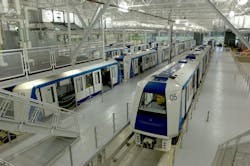“It’s time to start embracing the full spectrum of available innovative financing tools to provide a safe, efficient, and cost effective transportation system now and for the future.”
Public transportation infrastructure construction requires large budgets, creative financing and experienced contractors to maximize efficiency while minimizing operational disruption. Often these projects are funded through public-private partnerships (P3), in which a public agency contracts with a private sector entity to finance and manage the project. Within P3 there are a few models a construction project can follow, most traditionally a Design-Build model in which the construction team is responsible for the design and construction of the project, but hands the asset back over to the public agency upon completion. But now there is another model that is revolutionizing the construction industry with many benefits for all parties when successfully accomplished.
A new model
Public-private partnerships are increasingly being used in the United States to facilitate the delivery of major infrastructure projects in the transportation sector, where its use can accelerate the timeline for completion. The Design-Build-Finance-Operate-Maintain (DBFOM) model is relatively new, but currently gaining popularity in public infrastructure projects such as roads, bridges and airports. DBFOM requires a long-term involvement in the project by the developer and gives the public agency the assurance of stability in both financial and practical ends.
The Port Authority of New York & New Jersey recently announced that LaGuardia Airport’s redevelopment will be delivered by this method. Construction of the project will be funded by a public-private partnership, with the private sector contributing about $2 billion and the Port Authority contributing over $1 billion to construct the airport and supporting infrastructure.
Most recently, Los Angeles World Airports (LAWA) announced they would pursue this model to deliver a world-class transportation system to Los Angeles International Airport through the estimated $5 billion Landside Access Modernization Program, which will be the largest public-private partnership procurement in the history of California.
Deborah Flint, executive director of LAWA said, “The DBFOM method allows for a process that benefits LAWA and is inclusive of our values; comprehensive environmental review, transparency with our communities, project labor agreements and participation opportunities for local and small businesses.”
Financial flexibility
Large infrastructure projects necessary to upgrade or modernize transportation are often difficult to fund directly through a public agency where funding can depend on many factors. They typically require multiple funding sources and numerous partnerships of key public agencies and private sector participants.
A public-private partnership allows for more flexibility in access to funding while transferring much of the responsibility of the project away from the public sector. Projects can be started with less upfront capital from the public agency and in the case of a DBFOM, payments are made over the long-term life cycle of the project. Costs are consistent over time for the public agency and can be made in the form of availability payments which are adjusted for inflation and tied to project performance.
The public agency is able to factor the costs into a long-term budget and count on those funds to not only complete construction, but also operate and maintain the asset, allowing them to allocate their resources to other existing priorities.
Shared risk
Allowing the DBFOM team to maintain the project infrastructure ensures long term reliability because their responsibility does not end at project completion. Being fully invested in the project, they assume the risks associated with its maintenance and operation, thus it is in their best interest to innovate, produce exceptional results and ensure the project is successful.
Agencies get an experienced construction firm who completes the project with the resources and knowledge to manage the asset to its full potential since payments depend on their performance.
When there is only one primary firm involved in the project, disputes between multiple interacting entities are reduced, resulting in fewer potential legal impacts during the project life-cycle. When challenges arise, the developer is responsible for finding an efficient solution and is incentivized to keeping the asset fully functional throughout the process. When millions of people are depending on the services of the public agency to meet their transportation needs, it is beneficial to have a private team partner with expertise managing and maximizing their valuable infrastructure.
The benefits include expanding the financial capacity of public agencies with access to private capital, accelerating the delivery of costly infrastructure projects and ultimately, better management of public assets.
Airport DBFOM Projects
San Juan’s Luis Muñoz Marín International Airport in Puerto Rico was the first privately funded DBFOM project to be completed at an airport and is currently operating under a 40-year lease to the private firm responsible for the design and construction.
The project is a long-term airport concession that grants a private concessionaire the right to operate, manage, maintain, develop and rehabilitate the airport. The airport has five terminals and two runways with a capacity of 5 to 6 million enplanements. The public-private partnership deal included an upfront fee of $615 million.
Potential firms had to satisfy a list of criteria in order to be eligible to design and manage the project, including maintaining public use without discrimination, existing safety and security measures, and a limit on the percentage of airport fee increases. Although it is early in the lease period to judge the full success of the project, the improvements to the airport have been realized to the benefit of the public.
On Jan. 18, 2013, the city of Chicago received FAA authority to reinitiate the P3 procurement process for Chicago Midway Airport, issuing an RFQ the same day. This followed a previous failed attempt in 2008 when a deal with a consortium of investors fell apart due to the financial crises of 2008-09. Despite these setbacks, the state of Illinois remains active in alternative project delivery and has several projects in procurement.
John F. Kennedy Airport Terminal 4 is the only non-airline, privately-operated terminal at JFK that was delivered by DBFOM. The 1.5 million-square-foot opened in 2001 following a 4-year, $1.4 billion redevelopment that transformed the former International Arrivals Building into a first-class, efficient terminal facility. The concession is currently operating by JFKIAT, LLC under a 53-year lease.
Successful project delivery
Because DBFOM is a major investment with both public and private capital, the team leading the project must be a good fit with the long term goals. It requires a firm with a proven track record of P3 and DBFOM project successes, enough employees to service the needs of the project without compromise, and leaders with political communication experience in the public sector. There must be a good working relationship between key parties and a clear contract outlining responsibilities and performance expectations. A company with a long history is essential in assuring continuity over the life cycle of the project maintenance term.
HNTB’s approach to design-build helps the firm understand and provide services that result in the most efficient construction methods, saving both contractor and owner time and money. The firm’s expertise in major national aviation infrastructure projects spans many of the country’s most important airports, including Washington Dulles International Airport automated people mover tunnels and vehicle maintenance facility; Minneapolis – St. Paul International Airport light rail transit tunnel and station; and the Tampa International Airport Master Plan Update and Common Use Passenger Processing Systems, among others.
A win-win structure
Privatization of airports is often controversial because of their history as a public entity, but public private partnerships can allow for greater innovation in efficiency and travel experience. As many cities rely on tourism and travel, this can have a large impact on the financial health of the airport infrastructure. With the right preparation and execution, the P3 DBFOM model is poised to become one of the best options available to airports seeking to modernize and improve.
For major airport improvements, DBFOM can accelerate the project completion timeline, create cost efficiencies, make access to private-sector expertise available, assume shared risk, and provide long-term maintenance and operational programs.
It’s time to start embracing the full spectrum of available innovative financing tools to provide a safe, efficient, and cost effective transportation system now and for the future.
Peter Aarons is West Division aviation director and associate vice president for HNTB. He has more than 25 years of experience in planning, development, design, program and project management, and construction for airports.
About the Author

